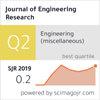天花板热管理用PCMS的实验与数值研究
IF 0.9
4区 工程技术
Q3 ENGINEERING, MULTIDISCIPLINARY
引用次数: 0
摘要
在本研究中,通过比较有相变材料(PCM)和没有相变材料(PCM)的两种建筑测试模型,基于环境温度变化导致的相变材料温度波动,对建筑天花板上集成相变材料(PCM)的热管理能力进行了实验研究。采用峰值熔点为31.10℃的商品有机PCM (OM-30)为PCM,高密度聚乙烯(HDPE)为包封材料。采用差示扫描量热仪(DSC)研究了相变温度、潜热、比热容等相变材料的热物理特性。本研究包括的各种PCM温度范围是(i)相变熔化温度范围以上ii)相变熔化温度范围内iii)接近PCM开始熔化温度范围iv)接近PCM结束熔化温度范围。在自由浮动环境条件下,PCM安装室内空气温度分别下降1.69°C、5.79°C、2.26°C、&;−2.87°C与无PCM相比,PCM熔化温度差为8.77°C,1.55°C,1°C &;分别为0.44℃。此外,据透露,PCM利用了3.2%,31.4%,6.9%,&;为产生1.69°C、5.79°C、2.26°C、&;−2.87℃与无PCM室相比。本文章由计算机程序翻译,如有差异,请以英文原文为准。
Experimental and numerical investigation of PCMS on ceilings for thermal management
In this study, experimental investigation of phase change materials (PCM) integrated into building on ceilings was assessed for thermal management capabilities by comparing two building test models with and without PCM based on fluctuation in PCM temperatures owing to ambient temperature variations. Commercial organic PCM (OM-30) with a peak melting point of 31.10 C was used as PCM with high-density polyethylene (HDPE) as the encapsulation. Differential scanning calorimeter (DSC) was used to examine the thermophysical characteristics of PCM such as phase transition temperature, latent heat, and specific heat capacity. The various PCM temperature ranges included for the study are (i) Above phase change melting temperature range ii) within Phase Change melting temperature range iii) Proximity to PCM onset melting temperature range iv) proximity to PCM end melting temperature range. Under free-floating ambient Condition, the indoor air temperature was dropped in PCM installed room up to 1.69 °C, 5.79 °C, 2.26 °C, & − 2.87 °C compared to without PCM room for a PCM Melting temperature difference of 8.77 °C,1.55 °C, 1 °C & 0.44 °C respectively. Also, it was divulged that the PCM utilized 3.2%, 31.4%, 6.9%, & 12.27% of the total latent heat energy deployed in order to produce a temperature difference of 1.69 °C, 5.79 °C, 2.26 °C, & − 2.87 °C compared to without PCM room.
求助全文
通过发布文献求助,成功后即可免费获取论文全文。
去求助
来源期刊

Journal of Engineering Research
ENGINEERING, MULTIDISCIPLINARY-
CiteScore
1.60
自引率
10.00%
发文量
181
审稿时长
20 weeks
期刊介绍:
Journal of Engineering Research (JER) is a international, peer reviewed journal which publishes full length original research papers, reviews, case studies related to all areas of Engineering such as: Civil, Mechanical, Industrial, Electrical, Computer, Chemical, Petroleum, Aerospace, Architectural, Biomedical, Coastal, Environmental, Marine & Ocean, Metallurgical & Materials, software, Surveying, Systems and Manufacturing Engineering. In particular, JER focuses on innovative approaches and methods that contribute to solving the environmental and manufacturing problems, which exist primarily in the Arabian Gulf region and the Middle East countries. Kuwait University used to publish the Journal "Kuwait Journal of Science and Engineering" (ISSN: 1024-8684), which included Science and Engineering articles since 1974. In 2011 the decision was taken to split KJSE into two independent Journals - "Journal of Engineering Research "(JER) and "Kuwait Journal of Science" (KJS).
 求助内容:
求助内容: 应助结果提醒方式:
应助结果提醒方式:


